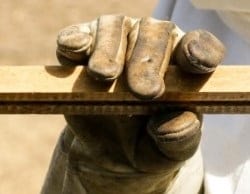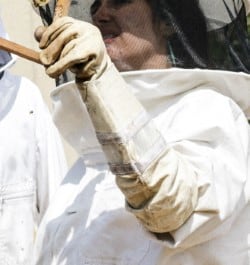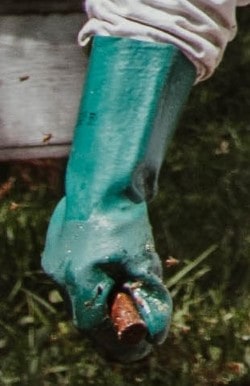As a beekeeper, safety for the bees and as well as the beekeeper is essential. Knowing how to handle the bees and also what to do during inspection can mean the difference between getting stung and escaping unscathed. There are many ways in which a beekeeper can keep their bodies stingless as they work with them. Picking and buying the best protective clothing is tantamount to not getting stung by bees. One article of protective clothing we will be discussing is the beekeeping gloves.
So, what is the safest glove for beekeeping and how do you pick them? The ones made from leather, with a snug fit and offers thick padding will provide the maximum safety as you handle your bees. However, dexterity and sensitivity will be compromised when using these gloves; this is the reason why professionals prefer thinner gloves or risk going gloveless altogether.
Using gloves for protection will help you in the long run. As you progress, you’ll be able to handle your bees without irritating them much, and from there you can pick a different set of gloves that would allow you to gain better dexterity.
Table of Contents
Reasons To Use A Glove
Gloves mainly protect your hands as you handle both hive frames and bees. It serves as a protective barrier between you and the possible chance of getting stung by your bees. As a beginner, you are required to wear protective clothing but will soon progress to a point where you too can also manage your bees confidently without gloves.
Another reason why even longtime beekeepers use gloves is for hygiene. It is easier for you to work with your bees without the feel for sticky honey, wax, and propolis on your bare hands. It is sanitary also because your hands contain oils and sometimes bacteria that can be harmful to the bees. Many professionals do inspect with their bare hands, but they wash their hands before handling their bees. There are also those that use gloves to prevent cross-contamination from one hive to another.
Choosing The Glove
There are a few things you need to consider when choosing a glove. These factors will help you determine the right kind of glove for your skill level. Most beginners will go for the thicker ones as they offer the best protection, and longtime beekeepers might forgo the gloves altogether.
Characteristic Of An Ideal Glove
Each glove set has different sets of characteristics that will give you a birds-eye view of the overall performance of the item.
Fit & Size
An ideal glove must fit your hands snuggly. Suitable fitting gloves offer you better sensitivity and make you less clumsy during inspections. Having an ill-fitting glove can lead to accidentally squishing bees or even difficulty in handling the tools you use.
Performance & Comfort
Consider your gloves as a second skin you wear when working with your bees. You need to be able to feel, handle, and move through them with ease. Sweaty hands can lead to your gloves getting uncomfortable as you work, especially if you have a big apiary. Breathable ones that offer some form of ventilation may help in this dilemma.
Protection Level
Most beginners will need to have thicker gloves as they are just beginning to learn the behavior of their bees and how to handle them without getting stung. More seasoned beekeepers will use thinner gloves because this offers the most dexterity and sensitivity as they work. Besides, they’ve been handling bees long enough to know how not to get stung. Beginners are advised not to use thin gloves but instead go for the thicker ones, for now.
Types Of Gloves
As an essential part of beekeeping protective clothing, gloves have evolved into many different types.
Leather

A beekeeper’s glove should perform like a second skin. That is why traditional gloves are made of goatskin leather or cowhide leather mixed with other components like canvas or cotton. These gloves are what beginners will have to have in their arsenal. They offer the most protection because of their thick construction. Designed not to let the stings penetrate deep enough to your skin, it is also durable and will last a long time with proper maintenance.
The cons of leather gloves are that they are bulky and uncomfortable to wear. It causes your hands to sweat and is hard to clean. Often enough, the constant subjection to honey, beeswax, and propolis cause the leather to stain, which is why maintenance is an issue here. It costs anywhere from $10 – $15 depending on the leather and construction.
Cuffed And Ventilated

As you progress into your beekeeping hobby, you will encounter days when the sun and sweat make it so damn uncomfortable to work on inspecting your hive. Having a glove that is has a ventilated sleeve allows for air to seep into the glove, therefore, cooling your hands and preventing it from sweating. The cuffed design provides further protection from stings, letting you enjoy your time with your bees without the fear of getting stung.
Most ventilated sleeve and even the cuffed sleeve designs of beekeeping gloves are a combination of leather and lighter material for the sleeve. This design means that some costs as much as 20 dollars. It still is bulky, which means that dexterity while wearing the glove might be an issue.
Nitrile or Rubber (Synthetic)

This type of glove has been so accessible to longtime bee handlers because it offers excellent sensitivity, dexterity and is just more comfortable to wear compared to leather gloves. They come in various thicknesses as well so you can choose from a thin medical glove to a thicker more cut protective glove, as pictured. They are much more hygienic too, and easy to wash.
The drawback is that these gloves are made from a disposable synthetic material that adds to the carbon footprint you leave behind and offers the least amount of protection. A pack of 50 pieces costs around $15 in stores.
The Safest Glove Vs. The Ideal Glove
Out of the three mentioned above, the safest glove would be the leather ones. They offer the most protection for beginners, and you can work your way out of it as you progress.
However, using this type of gloves would compromise your movement during an inspection. Since it is bulkier – to protect you from stings – it also offers less sensitivity, which can be hard to deal with at times.
An ideal glove, on the other hand, is one that fits your hand perfectly, has enough sensitivity to let you work without issue, and allows you to perform your job with dexterity.
Keeping Your Glove Safe
Your glove will be subjected to sticky situations (literally). Honey and beeswax will stick to them and getting them removed after you’ve done your inspection is essential.
Leather gloves, cuffed gloves, and ventilated ones are the hardest to deal with in terms of maintenance. While reading forums on how longtime beekeepers clean their gloves, I found three ways:
- Use a mineral oil laxative (FGMO) that dissolves the honey and wax from the leather and then wash it in warm soapy water. Let it hang and rub some olive oil on the leather to keep it soft and pliable.
- Throw it in the washer! Don’t mix other clothes with it though and you have to clean your machine after the cycle as the wax may stick to the inside of your washer’s drum.
- Soak the gloves in chlorinated water overnight. Soaking it in chlorinated water will dissolve the wax, but then since they have leather parts, you might be shortening the lifespan of your glove.
Nitrile gloves, on the other hand, are easier to clean. Since they are disposable, you can take off the gloves and throw it in the trash. But for those who want to lessen the garbage they make, they use warm soapy water to wash off the honey from the glove and let it air dry so they can use it again. A beekeeper suggested keeping a bucket of bee-friendly soapy water nearby as you work on your hive. All you have to do is dip your hand into the mixture when you feel that it is becoming too sticky.
The Stuff You Don’t Know
Old school beekeeping gloves use to make your hands look twice its average size. They were so bulky and often cumbersome. The first few were constructed only to cover the hand area and not have a sleeve that can protect your arms. Fast forward to today, you will still see heavy duty gloves on the market, but they are constructed in a much less bulky fashion, but it is the nitrile gloves that are taking the beekeeping industry by storm. They are sanitary, hygienic, and easy to use.
Did you know? Old styled leather gloves and even the newer versions are said to be attracting the bees to sting your more. They attribute this to the fact that leather is still skin and therefore, bees see it as such. Nitrile gloves, on the other hand, is made from synthetic materials that bees don’t find interesting, so they sting you less.
Conclusion
Just a quick recap of the article, beekeeping gloves are essential protective clothing for beginners to have. The right type can offer you both protection, dexterity, and sensitivity as you work. Comfort is another factor to consider, especially if you live in a tropical area, having breathable gloves cool you down and prevent sweaty hands. Choosing the safest glove may mean that you have to sacrifice on some essential aspects of a glove. The safest one is not always the ideal one for the job. No matter what you choose, the main thing you need to think about is if you can perform your job well with your gloves.
